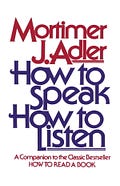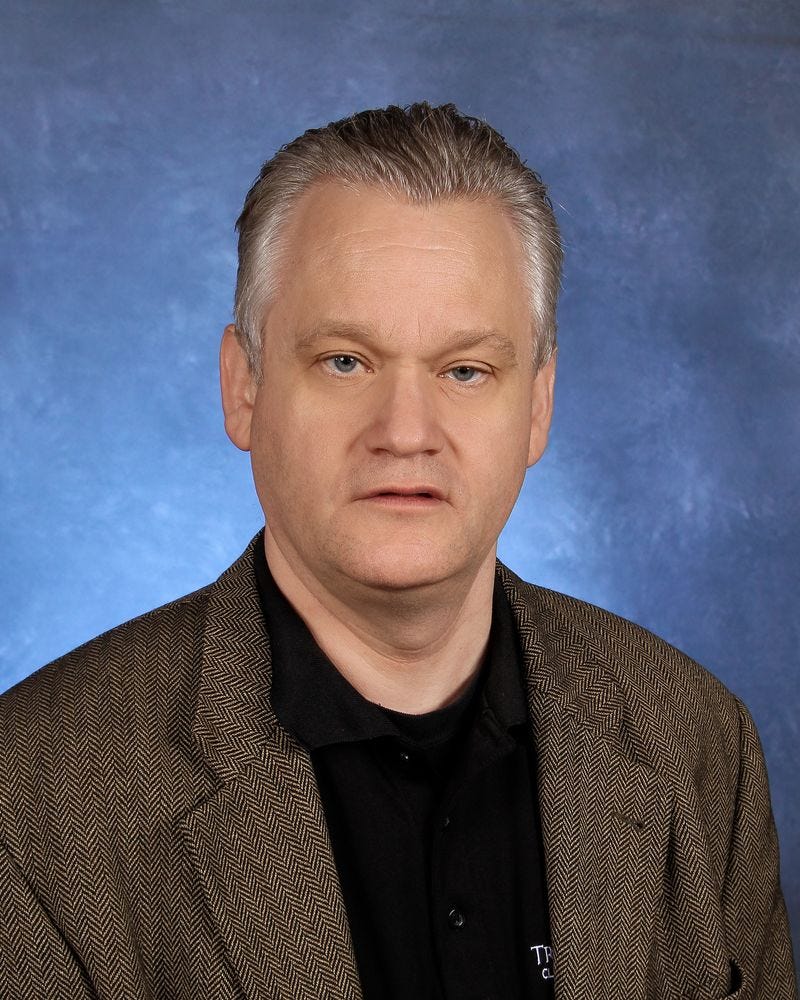Adler, Mortimer. How to Speak How to Listen. Touchstone, 1997. (paid link)
Mortimer Adler's How to Speak, How to Listen (1983), a belated follow-up to his bestselling classic How to Read a Book (1940) is flagged on the cover of the Touchstone edition as a self-help book, but the text far exceeds that descriptor. True to the form of his master and forebear, the great Aristotle, Adler defines and distinguishes the genus and species of his topic with the skill of an expert surgeon bearing an unusually sharp lancet. The effect of this is often to illuminate and clarify. It is also to render assertions that seem self-evident and elementary, yet which excluded would render incomplete the whole, such as "Listen to whoever is speaking and make it apparent that you are listening by not letting your eyes wander or your attention be diverted."
True to his own form, the author of Aristotle for Everybody reduces his topic to an everyman simplicity without doing it a disservice. Essential to this is the urgency that Adler imparts; this is no mere self-help book but addresses the core of essential and topical human needs in politics, education, business, and culture. Adler reminds his readers how essential effective conversation is for our very regime:
"A public discussion of political issues, by the people at large as well as by those in public office or the candidates for such offices, is the lifeblood of the republic. A republic in which there is no discussion of the res publica--the public things that we refer to as public affairs--is as much a caricature of its true self as would be a military organization in which there is no armament and no strategy and tactics for the use of arms."
Adler is at his most persuasive in his epilogue, where he lays out an urgent appeal for better conversation, better listening and speaking, in all human endeavors. After first discussing conversation as a properly human activity, Adler details its importance for private life, business, politics, and, indeed, for the survival of the human race. As the specter of nuclear war again raises its hideous head with a new possibility of a major European war, Adler's words remind the reader of just how urgent our situation is: "International wars begin when diplomatic conversations between nations fail. They are presaged by newspaper reports to the effect that 'conversations are deteriorating' or that 'conversations have broken down.' Then, if the conflict of interests between nations is sufficiently serious, there is nothing left for them to do but fight to secure their national interests." Here, Adler's voice comes forth from a Cold War past to tell the reader that he needs this book right now. This epilogue in itself is worthy of reading with students at the beginning of any class, in any field, as a touchstone for the language that will be exchanged over the course of study.
Read more: Battle for the American Mind
After a prologue in which he establishes the urgent need for speaking and listening well, Adler takes on various types of speech, beginning with uninterrupted persuasive speech, for which he favors the term "sales talk.” Adler analyzes the appeals to the Roman people by Brutus and Anthony from Shakespeare's Julius Caesar according the classical criteria of ethos, pathos, and logos, introducing the topic of rhetoric and making clear applications to contemporary forms such as advertisement and the sales pitch. From here, Adler moves naturally to another form of uninterrupted speech, the lecture, which he defines as "instructive speech," making a distinction between the goals of conviction and persuasion, one more suitable to math and science and the other to less exact disciplines. Unlike his treatment of the persuasive speech, Adler's treatment of the lecture is largely practical, covering ways by which to approach the task, including outlining, for which he provides a substantial appendix. However, he does apply the classical categories of taxis and lexis and terms such as "proem" and "proration" in his comments, reminding the reader that in all that he is doing, the classical tradition remains fundamental. Although much of the advice given might seem elementary to an experienced educator, having it digested in one reference might be helpful for both teachers and students of public speaking.
In Part III of the text, Adler addresses the topic of listening, identifying it as a task both more difficult and more in need of urgent attention than reading. The initial gist of his argument treats the need for active listening, as distinguished from hearing, of the sort that one might engage in while watching television. Adler emphasizes this distinction and highlights it with specific references to the Sperry Corporation's prominent campaign in the 1970s and 80s, which identified "deficiencies in listening and the failures of communication that ensue from such deficiencies . . . [as] a major source of wasted time, inefficient operation, miscarried plans, and frustrated decisions in every phase of the business in which the corporation is engaged." After, establishing this ground work, Adler becomes practical and discusses approaches and tips for effective listening, with special emphasis on note-taking. This part of the text might be of particular use while training learners of all ages to do serious academic work.
Adler tackles his final major topic in Part IV: two-way talk. He first treats forums and seminars each in a dedicated chapter, the latter of which references in detail both the guidelines that he laid out in The Paideia Proposal: an Educational Manifesto and his experience with The Aspen Executive Seminars of St. John's College. Next, Adler addresses conversation in the conventional sense, as a talk between two or more people. Again, following his forebear and master, Aristotle, Adler distinguishes effectively between a variety of conversations: the playful and the serious, the personal and the impersonal, and the theoretical and the practical. He then turns practical again, giving what might be to some the commonsense advice of good manners (e.g. do not interrupt), yet also going beyond that in his advice about how to make conversation pleasurable and profitable. The chapters in this section of the book might be most useful individually to those who are interested in learning more about a particular form of two-way talk, for example for teachers of a seminar or for one who is going to organize or attend a forum.
How to Speak, How to Listen has seeming limitations. At times, it seems reductive and simplistic. Often, the sage advice that Adler gives is simply commonplace. However, neither the author nor the work should be judged. The intention of the text, as with any good handbook, is to cover all the essentials of a given topic, even the most mundane. One use of the book might be as a primer for faculty discussions about how to prepare for class and speak to students, not to mention how to train students to listen, training that is sorely needed and usually neglected.
One use of the book might be as a primer for faculty discussions on how to speak to students and prepare for class, not to mention how to train students to listen. The section on persuasive speech might serve at the beginning of a school year as a common reading for a faculty discussion how to speak to students when providing motivation or discipline. Next, Alder's discussion of instructive speech might be the basis for a professional development workshop, serving as a primer for new teachers and a review for experienced ones, who might be grouped to as complement each other's learning. As for the section on listening, this might be best used in a practical tutorial for students, with special emphasis on the suggestions regarding prediction and notetaking. Finally, Alder's discussion of the forum and seminar would provide essential guidelines for a humanities department. In short, Adler has written a practical book that should be used as exactly that–a tool.
Dan Finnegan is Dean of Faculty and Teacher of Humanities at Lumen Gentium Academy in Boonton, New Jersey. He has taught with Great Hearts Academies in Phoenix and True North Classical High School in Miami.


